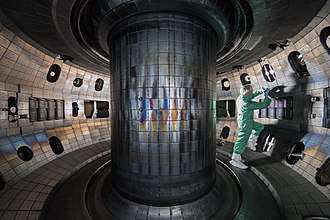DIII-D (tokamak)
DIII-D is a tokamak that has been operated since the late 1980s by General Atomics (GA) in San Diego, USA, for the U.S. Department of Energy. The DIII-D National Fusion Facility is part of the ongoing effort to achieve magnetically confined fusion. The mission of the DIII-D Research Program is to establish the scientific basis for the optimization of the tokamak approach to fusion energy production.[1]
 A worker inside the DIII-D vessel | |
| Device Type | Tokamak |
|---|---|
| Location | San Diego, California, US |
| Affiliation | General Atomics |
| Technical specifications | |
| Major Radius | 1.67 m (5 ft 6 in) |
| Minor Radius | 0.67 m (2 ft 2 in) |
| Magnetic field | 2.2 T (22,000 G) (toroidal) |
| Heating power | 23 MW |
| Plasma current | up to 2.0 MA |
| History | |
| Year(s) of operation | 1986 – present |
| Preceded by | Doublet III |
DIII-D was built on the basis of the earlier Doublet III, the third in a series of machines built at GA to experiment with tokamaks having non-circular plasma cross sections. This work demonstrated that certain shapes strongly suppressed a variety of instabilities in the plasma, which led to much higher plasma pressure and performance. DIII-D is so-named because the plasma is shaped like the letter D, a shaping that is now widely used on modern designs, and has led to the class of machines known as "advanced tokamaks." Advanced tokamaks are characterized by operation at high plasma β through strong plasma shaping, active control of various plasma instabilities, and achievement of steady-state current and pressure profiles that produce high energy confinement for high fusion gain (ratio of fusion power to heating power).
DIII-D is one of two large magnetic fusion experiments in the U.S. (the other being NSTX-U at PPPL) supported by the U.S. Department of Energy Office of Science. The program is focusing on R&D for pursuing steady-state advanced tokamak operation and supporting design and operation of the ITER experiment now under construction in France. ITER is designed to demonstrate a self-sustained burning plasma that will produce 10 times as much energy from fusion reactions as it requires for heating.
DIII-D Research Program
The DIII-D research program is a large international collaboration, with over 600 users participating from more than 100 institutions. General Atomics operates the San Diego-based facility for the United States Department of Energy through the Office of Fusion Energy Sciences.[2]
Research in DIII-D aims to elucidate the basic physics processes that govern the behavior of a hot magnetized plasma, and to establish a scientific basis for future burning plasma devices such as ITER. Ultimately, the goal is to use this understanding to develop an economically attractive fusion power plant.
The tokamak consists of a toroidal vacuum chamber surrounded by magnetic field coils which contain and shape the plasma. The plasma is created by applying a voltage to generate a large electrical current (more than one million amperes) in the chamber. The plasma is heated to temperatures ten times hotter than that of the sun by a combination of high-power neutral beams and microwaves. The plasma conditions are measured using instrumentation based on intense lasers, microwaves, and other precision plasma diagnostics.[3]
History
.jpg)
In May 1974, AEC selected General Atomics to build the Doublet III magnetic fusion experiment based on the success of earlier Doublet I and II magnetic confinement experiments. In Feb 1978, the Doublet III fusion experiment achieved its first operation with plasma at General Atomics. The machine was later upgraded and renamed DIII-D in 1986. [4]
The DIII-D program achieved several milestones in fusion development, including the highest plasma β (ratio of plasma pressure to magnetic pressure) ever achieved at the time (early 1980s) and the highest neutron flux (fusion rate) ever achieved at the time (early 1990s).
References
- DIII-D "DIII-D". Retrieved Feb 17, 2018.
- General Atomics - Magnetic Fusion Energy. "ga.com". Retrieved Feb 17, 2018.
- https://www.youtube.com/watch?v=YF0t3j_2WSI
- General Atomics History. May 1974 and Feb 1978."ga.com". Retrieved Feb 17, 2018. url=http://www.ga.com/Websites/ga/images/about/history/1974-may.jpg, url=http://www.ga.com/Websites/ga/images/about/history/1978-february.jpg
External links
- https://fusion.gat.com/global/diii-d/home General Atomics Fusion Energy and DIII-D Home Page
- https://www.youtube.com/watch?v=tA7J2s23lB8 Video about DIII-D produced by the American Physical Society on YouTube